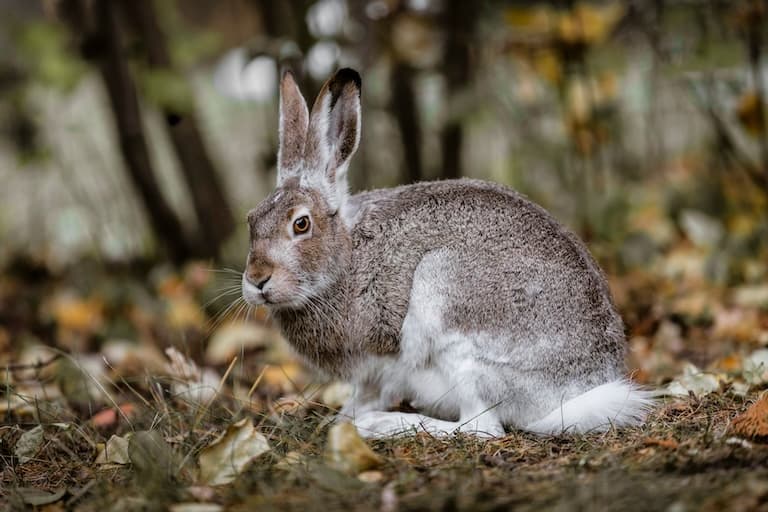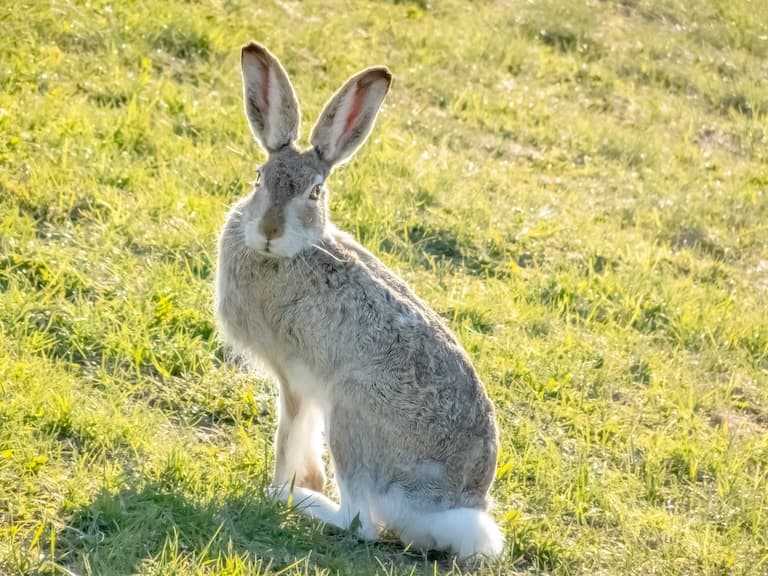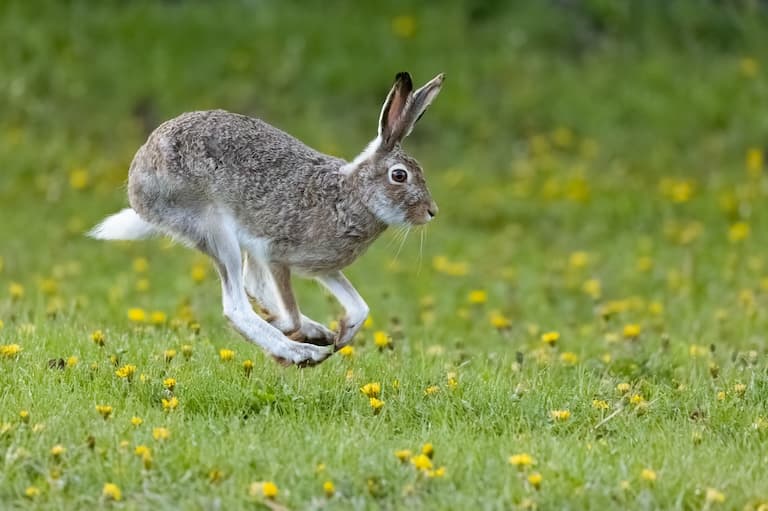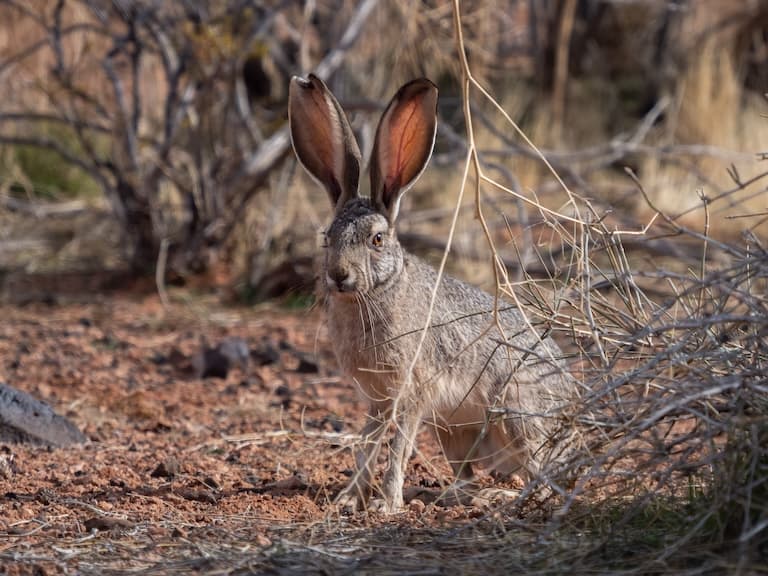White-tailed Jackrabbit Profile
“There are always hares. And the hares are vivid outstanding characters. You know, they stick out above all the rest because of their curious accents, their greed for food, but also their loyalty and their fighting qualities… And they have that sort of innate British upper-class accent… Y’know, that’s why I like working with them.”
– Brian Jacques
Hares are found all over Africa, Asia, North America and Eurasia, and they get a fraction of the attention afforded to their rabbity cousins, despite being far more valuable as warriors for the Badger Lords in Redwall books.
Today’s harem, the white-tailed Jackrabbit, is a North American specialist that continues to serve its ecosystem as it did when providing food for the first human settlers.

White-tailed Jackrabbit Facts Overview
| Habitat: | Plains, prairie, alpine meadows with scattered coniferous trees, and urban parks. |
| Location: | North America |
| Lifespan: | 8 Years |
| Size: | Around 75 cm (36 in) long |
| Weight: | Up to 4.3 kg (9.5 lb) |
| Colour: | Dark brown or greyish-brown back, lighter underneath, white tail |
| Diet: | Grasses, forbs, cultivated crops, buds, twigs, bark |
| Predators: | Coyotes, bobcats, badgers, red and grey foxes, mountain lions, wolves, snakes, raptors |
| Top Speed: | Up to 55 km/h (34 mi/h) |
| No. of Species: | 1 |
| Conservation Status: | Least Concern (IUCN) |
The white-tailed jackrabbit is a large and impressive specimen that can still move when it wants to. Spending the day hidden in cavities under cover, it forages at night, using tried and tested networks of pathways, even when they’re covered in snow.
Its major natural threats are from large and intelligent predators but an adult hare is a difficult catch, and this species is well adapted to hard times.
Unfortunately, its natural habitat is being converted for human agriculture, resulting in an unprecedented decrease in its number and local extinctions, but the species as a whole is still tenacious and plentiful enough for this not to be an emergency yet.
Interesting White-tailed Jackrabbit Facts
1. They’re hares
Jackrabbit is another word for hare, and hares are separated from rabbits at the genus level. As Lagomorphs, they’re rodent-like animals to look at and are related, but it’s not clear quite how much.
They were once much more diverse, though the order today contains only two families: one with the rabbits and hares, and the other with the mouse-like pikas.
Lagomorphs differ from rodents in their teeth configuration, having more incisors than rodents, and in their strictly herbivorous diet, compared with the omnivorous nature of most rodents.
Hares and rabbits differ in their attitudes and social natures. Rabbits are highly social and live in burrows, while hares are mostly solitary and live out in the open.
The white-tailed jackrabbit is one of the least social of all hares, and also one of the largest. But this doesn’t stop it from really shifting when it needs to.

2. They’re incredibly agile
Hares are the athletes of the lagomorph world, exposed as they are, relative to the subterranean sanctuaries and family protection that rabbits share with one another.
When they perceive danger, their first line of defence is to lie flat in a small divot, which, if you’re making eye contact with them as they do it, is quite comical.
But if the hare decides this isn’t going to work, it goes to the extreme opposite solution, rocketing off at alarming speed and employing remarkable springiness to bound about in a zig-zag, similar to the strategy of a Thompson gazelle when faced with a cheetah.
They accomplish and maintain this pace using incredibly powerful hind legs and built-in radiators to keep them cool. While this species isn’t the fastest sprinter among hares, it can still hit peaks of up to 55 km/h.
3. Their poop is impressive
The urge to poop usually comes from sensitive tissues in the rectum alerting your brain to the presence of matter.
This load in the chamber is the final part of your food’s digestive journey but it’s more than just an ejection seat.
The lining of the rectum is incredibly absorptive, allowing your body to pull back in valuable water that was released into the digestive tract to spread everything out and aid in its breakdown and nutrient exchange.
The longer it’s held there, the drier it becomes, but in humans, who are very water-intensive animals, it’s always going to have some water content.
In the white-tailed jackrabbit, this isn’t the case, and when there is little water around to consume, it can recall almost 100% of the water involved in its digestion, resulting in pellets of almost completely dry, fibrous matter.
Instead of sweating, they use their huge ears as radiators, dissipating the majority of their excess heat through the blood vessels on their surface. If it gets exceptionally hot, they’re able to allow their body temperature to rise a little, reducing their need to cool down.
All of these mechanisms allow the animal to exist relatively comfortably in very arid habitats.
4. They make snow tunnels
The white-tailed jackrabbits are nocturnal animals, kicking into gear almost exactly one hour after sundown, and ceasing activities before the morning light.
They’re more active in the cooler months, peaking around mating season in Spring, and hitting their lowest activity levels during the summer.
Part of this has to do with food (and mate) availability, which dictates their foraging patterns and can be seen reflected in the well-trodden paths the hares use on the regular.
These paths make convoluted networks of feeding routes that can span more than a couple of kilometers around the hare’s home range, and in the winter, the hares will spend their rest periods inside one of a network of small cavities, connected to one another via snow tunnels.
Predation puts significant pressure on their activity levels, and the hares will move less during a bright full moon than on a dark night. 1 2
5. They do ok in urban areas
Urban parks are a choice habitat for these animals, as there are fewer nocturnal predators, and the adult hare can escape all but the fastest and luckiest of domestic dogs.
This has its own drawbacks, as the baby hares can be taken by cats, dogs, or even humans, who think they’ve been abandoned when they haven’t.
In Canada, some regions issue public warnings not to accidentally kidnap wildlife, including these hares.

6. They contribute a lot
Despite being quite unsocial and low-density, this species is a very significant contributor to its ecosystem.
Its selective nibbling on plant species dictates the diversity and composition of the grasslands it feeds on, its manure recycles nutrients, and its presence supplies food for a plethora of predator species, from the American badger to coyotes, bobcats, and raptors.
They even provide occasional supplementary nutrition to wolves and snakes.
But humans are not so keen on them, often regarding them as a pest to crops, and this is contributing to their decline.
7. They’re in decline
The major threat to this species is the increasing conversion of their natural steppe and prairie habitats to agricultural land or pasture or other non-grass agriculture.
The species has become locally extinct in many parts of its prior range, and the persecution as a pest is not making things any better.
Still, as a resilient animal, it’s not dropping off at a rate thought to be of concern to the IUCN, yet. 3

White-tailed Jackrabbit Fact-File Summary
Scientific Classification
| Kingdom: | Animalia |
| Phylum: | Chordata |
| Class: | Mammalia |
| Order: | Lagomorpha |
| Family: | Leporidae |
| Genus: | Lepus |
| Species: | townsendii |
Fact Sources & References
- “White-tailed jackrabbit”, Washington Department of Fish & Wildlife.
- Gordon L. Rogowitz (1997), “WDFW Locomotor and Foraging Activity of the White-Tailed Jackrabbit (Lepus townsendii)”, Oxford Academic.
- “White-tailed Jackrabbit”, IUCN Red List.
